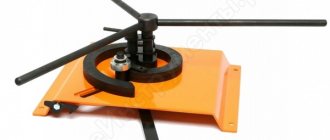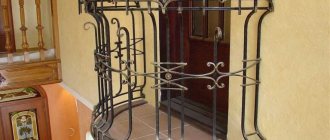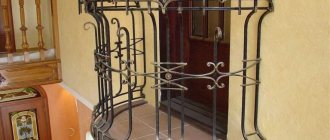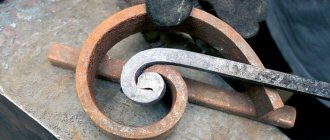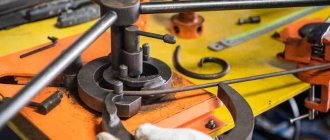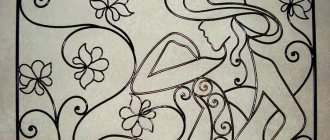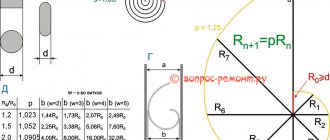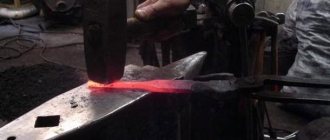SHARE ON SOCIAL NETWORKS
FacebookTwitterOkGoogle+PinterestVk
Blacksmithing is hard physical work that requires special equipment combined with specialized knowledge and experience of the master. However, to make some artistic elements, you simply need to bend the blanks at the desired angle. Metal deformation can be performed without heating mechanically; cold forging machines are used for this. What features do such units have will be discussed in this article.
Cold forging machine that allows you to create wave-like elements
Maybe you need a punch? Main concepts
You've probably already noticed that on our website we love to point out anything that's wrong. Now, too, we will not change ourselves: the concept of “cold forging” in its usual meaning is fundamentally incorrect, read carefully, we will explain.
First, what is forging: it is the processing of metals heated to forging temperature, that is, to the temperature when the metal becomes soft and can be deformed. Blacksmithing is all about forging - with a hammer, an anvil, a forge and mighty bearded blacksmiths wearing leather aprons.
Blacksmithing products are an exclusive and expensive business. And, in general, it is already exotic, if we exclude stamping, which is done automatically and in huge volumes.
Stamping is the extrusion or deformation of metal using a stamping press with a special matrix - a nozzle at the end. This is what it is - a punch that is made from the highest strength steel. Stamping can be hot, with heating of metals to forging temperature, and cold, without any heating. You don’t have to look far for an example of cold stamping - these are all metal drink cans.
Types of forging machines.
We are finally approaching working with metals in a cold way - without heating. Question: is it possible to deform metal without heating? Answer: yes, you can. The only way is mechanical. It is called a not very serious word - riveting or cold hardening. To do this, you will have to hit the metal with a hammer until you are stupefied until its structure begins to change significantly.
This process is precisely cold forging - mechanical deformation of metal blanks using mechanical blows with a hammer. If you decide to take up peening forging, then we say hello to your family and neighbors in advance - they will face serious challenges.
But seriously, there are fans of cold forging using the riveting method, we wish them success and move on to pseudo-cold forging, as they used to call it.
Mechanical deformation of metals using various machines without heating is more correctly called metal bending, because in this method of metal processing, craftsmen bend metal rods. They don't do anything else - they just bend. Another question is how and where they bend, along what axis, but all these are artistic aspects of metal bending, which we will also dwell on, but later.
The most important thing is that in the future we will call this process cold forging - as it is done in all sources, so that there is no confusion. It’s just that now we understand the methods and understand what the essence of the so-called “cold forging” is.
By the way, do you need a punch? It's a beautiful word. You won't be involved in industrial stamping of metal blanks, will you? But artistic forging with your own hands is a very real possibility at home. There is even light stamping along with punches... Let's look into it further.
Connecting parts and painting
Now all the curls need to be collected into a single canvas. The work is not easy, but very rewarding: it is at this stage that the main artistic idea begins to be realized. Meanwhile, at this stage you can easily ruin everything. This is easy to do: start connecting the parts by welding, and then use a grinder to clean them.
But we have already talked about the professional ambition of cold forging masters, which can only be welcomed. Special U-shaped clamps, which are stamped on inertial machines, will look much more impressive. Don’t be lazy, but work well with the clamps - this is the key to successfully completing the forging of the product.
Torsion of metal on a machine.
Now about painting. Thank God, now there is something to paint: thanks to modern construction technologies, there are a huge number of paints on sale for every taste, budget and, most importantly, purpose. There are countless paints for metals. Most often, special acrylic paints for metal or blacksmith's enamels are used.
Very often, for completely unknown reasons, blacksmiths prefer a finish coat with paint with pigment from a forge patina - “antique”, showing an amazing unanimity in tastes. If you are a forging customer, then you need to stop the craftsman in time to offer him your own version of the color and texture of the coating. But seriously, who said that forging should be dark and antique? And the white one? Colored? This is where there is vast space for the most daring artistic solutions.
Types of cold forging machines
We reason logically and point by point. You cannot bend metal with your hands, no matter how hard you try. Do-it-yourself cold forging is done only using special machines. It's all about them. This is the first point. One machine is not enough; there are a whole bunch of them. This is the second point. Some of them can be done with your own hands.
If you decide, you will need drawings for cold forging machines. How many and what kind of machines you need to have to do what you need and like depends on what you need and like. Exactly like that and in that order.
We take the rod. There are only two options to bend it:
- Along the axis so that the rod begins to resemble a twisted cord.
- Across the axis in the form of various curls, waves and bends.
Types of forging tools.
All cold forging machines are divided into four groups according to the same principle:
- Torsion bar machines that produce longitudinal helical twisting of rods and various filaments, which we will discuss below.
- Twisters for forming curls and spirals with a narrow center.
- Bending machines for waves and zigzags.
- Stamping machines for flattening the ends of rods in the form of legs, clamps and other patterns.
Devices for bending metal elements “Snail”
To bend workpieces according to certain parameters, auxiliary conductors are used, called “Snail”. They serve as a special template that allows you to reproduce dozens and, if necessary, hundreds of similar parts. The “Snail” machine for cold forging bends parts without additional heating.
The work is based on the deformation of metal according to a certain principle. To bend, you have to put in a lot of effort. Therefore, craftsmen quite often equip “Snail” devices with an electric drive. Geared motors help to develop significant forces with a limited shoulder of force application. The torque in the processing area can reach several tens of kilograms.
If such work is performed only due to the physical strength of the blacksmith, the worker will get tired quite quickly. Its productivity will drop to zero. And with a mechanical assistant, hundreds of workpieces can be produced per shift.
It must be taken into account that bending of workpieces is an intermediate stage in the manufacture of complex structures. They still need to be installed in the right place and welded. Only then will an intermediate result be obtained. Then the product will need to be painted and installed at the place of order. All operations will require not only time, but also the physical strength of the master.
Structurally, the device can be:
- Non-separable, then it will be used to bend parts only to certain lengths. The resulting spiral has certain limitations in use.
- Prefabricated (there are additional fragments to increase the bending time), and the device can be used to bend long parts. Large sized parts will be received.
To work with parts from small profile pipes, some make manual devices. They involve the use of levers to help move the workpiece around the mandrel. The finished parts are removed from the end, slightly loosening the tension.
Most often in such cases I use square bars □8...12. Some craftsmen manually bend profile pipes 15·15 mm with a wall of 1.5 mm. For larger products, a mechanical drive is required.
Which machine is most needed?
Do-it-yourself cold forging machine: which one is the most necessary and which one to start with?
There is no clear answer to this question; you must decide for yourself. To make a smart decision, let’s go through the main types of machines to have an idea of their functionality and, most importantly, DIY manufacturing methods. You should remember what materials you will have to work with during the cold forging process: these are metal rods or rods with a diameter of no more than 14 mm, squares and strips with a thickness of approximately 3 to 6 mm with a width of no more than 25 mm.
A complete gentleman's set of machines in the workshop for full-fledged work will look like this:
- twister with snails for obtaining spirals of various radii;
- bender for bending arcs and parts at different angles;
- wave for curved parts and processing of metal pipes;
- globe for obtaining large arcs from profiles;
- flashlight for bending parts;
- volumetric
You don't have to have it all at once. It’s quite possible to start work if you have two machines from the first two points - a twister and a bender. Forging with your own hands has a great advantage: you can choose what to do and where to start. Let's start the review with the most popular machine - the twister or the famous snail.
Twisters
Since ancient times, blacksmiths have cold-formed curls according to a template-mandrel using a horn lever grip, pos. 1 in Fig. This method is low-productive and not for wimps, but it allows you to quickly and easily make various bending mandrels from an ordinary steel strip: the end (thrust) horn of the lever prevents the template from yielding under the pressure of the workpiece. It is advisable to make the middle (bypass) horn sliding with fixation: the work will go slower, but, especially in inexperienced hands, more accurately.
The simplest devices for cold artistic forging
Another simple device for manual shaped bending is a strong board with support pins - spacers, pos. 2; Ordinary M8-M24 bolts are suitable. Depending on how friendly you are with your home exercise machine, you can work with a strip of up to 4-6 mm. They bend the strip by eye, the work goes slowly, but you can draw patterns up to Ilya Muromets on a horse in full armor or Buddha in a lotus flower. The latter, perhaps, is completely handmade: people who have fully mastered hatha and raja yoga are able to curl steel reinforcements into a pattern with their hands.
Making a snail with a lever
Drawing of a forging machine.
Before you begin the practical part of the work, you need to prepare theoretically. We are talking about calculations and drawings of the machine and its parts. Nobody will give you the exact dimensions, because this is an independent design.
Much will depend on the availability of similar materials, the scale of future cold forging work, the dimensions of the room where you are going to work and many other factors. The main thing is the principles that you need to understand in order to make a homemade cold forging machine with your own hands - the most convenient option for you and only you.
Here's what you need to gather before you begin assembly:
- metal plates or tabletop cloth with a thickness of at least 4 mm;
- metal round pipe for a rack or frame;
- metal rod;
- bearings of different calibers;
- drill;
- welding machine;
- hacksaw for metal;
- M8 bolts.
Basic parts
The twister has only four basic parts. Pay special attention to their preparation and, most importantly, installation:
- frame or stand;
- table top;
- main shaft;
- lever arm.
Rack
Only made of metal, no wooden beams. We place it in a thoughtful place so that you have access to the machine from any side. The machine will be subject to heavy loads, so the best option may be a thick-walled pipe or a metal corner.
It is best to concrete the stand directly into the floor, it will be reliable. Externally, this design may resemble a stool. As strong as possible - this is the main principle of producing a countertop stand. Therefore, it is better to connect metal parts by welding.
Tabletop
Homemade forging machine.
The most important part of the machine, which is best made from a metal plate with a decent thickness, preferably at least 5 mm. In the production of forging machines with your own hands, you cannot save on the thickness of the metal, because the table top and other basic elements will take on a huge load.
The preferred shape is a circle. You need to make two of these tabletops: the second is needed for bending the rods and placing the snails.
Main shaft
From the same metal plate, cut four right triangles with equal sides. Weld the triangles to the bottom of the structure, and their base is in the center of the circle. Another shaft option is not made from triangles, but from a pipe with thick walls of a suitable diameter. Fasten either with bolts or welding.
Lever or handle
And again “as tightly as possible”: attach the lever to the shaft with a ring so that it rotates around it. Attach the bending roller to the top tabletop. It is very important to correctly calculate the length of the lever, which depends on the diameter of the tabletop circle. One rod should be approximately equal to this diameter, the second rod should be longer.
Bearings are attached to the lever at its end, this is done to provide greater freedom in the directions of movement of the lever. The lever elements and fixed triangles are secured with a special round nut with a large diameter.
Attachment parts
Be careful here, you need to choose the degree of complexity or, so to speak, “artistry.” We have three options for you.
- Simple static snail
The simplest and therefore most primitive option from an artistic point of view. You apply a drawing of a snail, that is, a spiral, directly onto the tabletop.
In no case do we ignore the requirement in the drawings - cold forging loves precision and thoughtfulness in everything.
Then cut out segments from thick metal strips repeating the snail pattern and weld them as firmly as possible perpendicular to the tabletop. Simple, but not at all ingenious: on this tightly welded snail you can only make the same simple bends without any flight of creative thought.
Metal bending machine.
However, it all depends on what you are going to forge. If, for example, you have plans for a long wrought-iron fence with a simple design, then a simple static snail will be the best option.
- Collapsible snail made of removable parts
Let’s say right away that this is the most popular option among amateur craftsmen. The contours of snails are also applied to the tabletop. Threaded holes are drilled along this contour. Snail segments from metal strips are prepared using cardboard templates, and exactly the same matching holes are drilled into them as on the tabletop.
The segments are not welded, but are secured with bolts or cylindrical stops. The main advantage is the ability to bend spiral parts with different radii and different numbers of revolutions.
- Modular system with different snails
An option with the greatest artistic freedom for forging with your own hands: instead of segments with stops, removable modules with different snails are used here - both in shape and size. The modules are prepared on separate metal platforms on which the segments are welded.
Of course, you need to tinker a lot with such a machine, but this game is worth the effort: you can forge real metal lace. It all depends on your plans: a simple fence or a lacy gazebo in the garden?
Diagram of the bender and the sequence of work on it
Let's look at the design of the device using the example shown in Fig.
2. The simplest device for cold forging consists of - a base mounted on a table/workbench, touching a moving lead, which performs bending;
- a lever that moves the leash;
— a dial with an indicator of the angle of rotation of the lever;
— replaceable rollers with different bending angles;
- adjustable spacers and clamping jaws that fix the part in a certain position.
Figure 2 — General view of the bend
The sequence of manufacturing bending for cold forging is as follows. The device is attached to the table/workbench or installed on it. For bending metals that require significant force, it is better to mount the device permanently, for which holes are provided in the support angle. A slider is placed in a rectangular steel frame, the internal surfaces of which must be ground. The following parts are installed on the upper plane of the slider:
- A replaceable punch, on the working surface of which there are all the most commonly used options for bending workpieces: radius, arc, straight bend, etc.
- A lever with which you can move the slider back and forth.
- Slider travel limiters in the device frame.
Having installed the replacement tool, bolt the frame to the supporting surface of the bend, after which two rollers are installed on the upper plane. It is better if the rollers have the ability to move longitudinally along the frame: this will allow bending of workpieces of various thicknesses or diameters. For this purpose, the grooves for fastening the rollers are made oval, taking into account a certain range of changes in the thickness of the workpiece. The axes of the rollers must allow free rotation: this will reduce the bending force and eliminate clamping of the rollers when bending products made of stronger metals.
To increase the accuracy of bending in the manufacture of forging tools, a dial with divisions graduated in the bending angles (taking into account the springing of the metal) is often installed on the support angle.
Having secured the workpiece, gradually move the lever until it approaches the workpiece, then adjust its location between the rollers and the slider and bend it to obtain the required angle. To facilitate the process of returning the slider to its original position, it can be equipped with a return spring. Its force is selected taking into account 20-25% of the bending force. This force can be determined either using an existing dynamometer or using an approximate relationship:
Р = 0.25bSσв, where:
b - strip width (or rod diameter);
S—thickness of the material being bent;
σв is the limit of tensile strength of the workpiece material (see table):
Thus, the functionality of the bend will be determined by the presence of replaceable punches, the ability to adjust the position of the workpiece in front of the bend, as well as the dimensional scale that sets the bending angle.
Making a torsion bar machine
Torsion treatment is fundamentally different - it is a screw twisting of the rods along. This machine is very easy to make with your own hands. The main thing in it is to ensure a strong fixation of the two ends of the metal rod; the success of screw twisting depends on this.
At one end the rod should hold tightly, at the other it should rotate with the help of a lever. The components of the torsion bar are a metal cylindrical blank made of a profiled pipe and two fastening elements with a locking device. They can be made from bearing units.
The clamps have nuts welded into the bolts that are tightened to hold the metal rod.
If your plans include “pump up your biceps and triceps,” be sure to make a torsion bar machine and start twisting the rods by hand. Torsion forging is not for the weak, you will develop excellent muscles in the upper shoulder girdle. But one way or another, it is better to make the lever for rotation longer, it will be easier.
Bends, flashlights, waves and other machines
As you can see, we have collected all other types of cold forging machines in one small section. Why is there such disrespect for them, in contrast to the snail and torsion bar, which we talked about in separate sections? The answer will be honest in the form of advice:
If you decide to make a forging machine with your own hands, opt for two machines: a snail and a torsion bar. Firstly, they are absolutely necessary from a functional point of view, and secondly, they are quite simple to implement independently.
Types of cold forging.
The remaining machines, such as a flashlight or a wave, can be built much later, when you realize that cold forging is for you, and when you have specific creative plans in your head.
But there is a third machine after the volutes and the torsion bar, without which it will not be possible to start cold forging. This is a bending machine. Outwardly, it seems the simplest of all, and its function is the most seemingly simple: bend rods at a certain degree or make waves of different sizes.
There is no need to make a bending machine yourself; it is better to buy it ready-made for two important reasons:
- Wedges and rollers, which are used to change the dimensions of manufactured elements, must be machined to the ideal dimensions. It is almost impossible to do this at home.
- Bending machines are very inexpensive, so the budget saving requirement will be met.
Having at your disposal the three most necessary machines - a self-made volute and torsion bar and a purchased bending machine - you can begin cold forging of almost any complexity. There is one more small issue left to resolve.
Manual drive or electric?
The electric drive can be installed on any machine. Another question is – is it necessary? Again, the decision depends on your plans. The electric drive will allow you to save your own energy. But this is not its main advantage. The torque with electric force will be more uniform, and this will lead to smooth and uniform forging elements.
Drawing of a cold forging machine.
The number one contender for an electric drive is a torsion bar machine, where it is extremely difficult to maintain uniformity of screw twisting by hand. It's also very easy to do. You will need a drive axle axle shaft of an old car, a differential gear pair, and a protective sleeve. The power of a homemade engine should not be high - no more than three kW and no higher than 900 rpm.
As for the electrification of the remaining machines, decide for yourself. If you plan to do cold forging for your own needs, you are unlikely to need electric traction.
Making a cold forging machine with your own hands is a difficult and very exciting task. The better its implementation, the easier it will be for you to work on it. And the more beautiful your metal lace will turn out.
We wish you strong snails, high-quality rods and true connoisseurs of your blacksmithing art.
